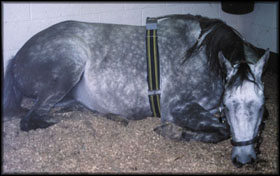|
|
"Bedding in the
horse stable...
a breath of fresh air" By Susan Raymond, Equine Research Centre,
Guelph, Ontario
The health and well being of
horses depends on healthy lungs. Poor air quality can contribute to various
respiratory disorders in horses and in the people who care for them.
Bedding
Choice
Your choice of bedding will depend on a
combination of personal preference, cost effectiveness, local availability and
type of horse housed. Bedding should be dust and mould free, absorbent,
supportive and easy to use and dispose of. A barn with proper ventilation and
floors with good drainage are as important as your choice of bedding.
Dust
 |
Dust in the stable can be an
irritant, infectious or allergenic. Each particle can play more than one role.
Dust can be divided into two groups, "nuisance dust" and allergens.
"Nuisance dust" includes plant particles that can irritate the
respiratory tract. Allergen sources include mould spores, pollen and mites. The
chance of a dust particle inducing disease as an irritant or an allergen is
dependent upon the amount retained in the respiratory tract. Deposition and
clearance of particles are dependent on the size, shape and type of particle
that is inhaled. The smaller dust particles have a higher chance of reaching
the lower airways. |
Mould
| There are many types of mould
living in the field where our crops are grown (i.e. straw). The spores from
these types of mould ("field fungi") are usually large and do not
have a good chance of getting into the lower airways. The mould spores that are
more dangerous are small. The highest exposures to these mould spores are
associated with bedding that has been processed, packaged or baled damp and
with deep litter management. The high moisture content influences the fungi in
the bedding and metabolic activity of the organisms causes the temperature to
rise. The moulds that thrive in this high moisture and heat are very prolific.
The spores from these moulds are very small and when inhaled can travel deeply
into the lungs. |
 |
Ammonia
Ammonia is an irritant and is a recognised
concern of stable management. The source of ammonia is the horse's urine and
faeces. Ammonia is released by the action of bacteria that degrade organic
matter. Ammonia inhibits the ability of the defence mechanisms in the airways
to remove particles from the lung. Ammonia can also increase mucus production.
Ammonia can be particularly high when stalls are being mucked out. If the horse
is left in the stall during mucking, it will be subjected to high levels of
ammonia and high levels of dust. The more absorbent a bedding is, the lower the
levels of ammonia will be. Take action if you smell ammonia in your
barn.
Barn
Management Tips
- wet all hay that is fed indoors and feed close
to ground level or feed a good quality, low dust alternative forage product
- remove the horse from the barn when mucking
- sprinkle the barn aisle with water when
sweeping or raking
- use a quality bedding and muck out daily
(avoid deep litter systems)
- consider barn ventilation for all seasons
- increase turnout time with shelter
How does your
Bedding Rate?
| |
Low
Dust |
High
Absor-
ption |
High
Cushion Support |
Manage-
ment ease |
Comp-
osting Rate |
Low
Palat-
ability |
Cost |
Comments |
 |
|
|
|
 |
Fast |
|
Low |
Can shift expose bare
floor if not bedded deep enough or if horse is very active in stall |
 |
 |
 |
 |
 |
Slow |
 |
Med. |
Do not use treated
wood or certain hard wood (black walnut, yellow poplar).
Kiln dried pine shavings recommended |
 |
 |
 |
 |
|
Fast |
 |
High |
|
 |
 |
 |
 |
 |
Med. |
 |
Med. |
Variability between
products
Avoid glossy paper
Requires regular mucking out or can become packed down |
 |
 |
 |
 |
 |
Med. |
 |
Med. |
Variability between
products |
 |
 |
 |
 |
 |
Med. |
 |
Med. |
Variability between
products |
 |
 |
|
|
|
N/A |
 |
Med/High |
Variability between
products |
|

